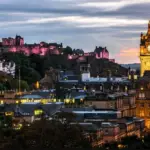
The unspoiled beauty of the Scottish Highlands
To the Highlands, Also known as the Scottish Highlands, they are a region of stunning splendor and rich cultural heritage. Situated in the north of the country, encompassing some 15,000 square kilometers of mountainous terrain, deep valleys, and serene lochs, these remote and unspoiled lands are widely acclaimed as one of the most picturesque destinations on the globe. The Highlands are notable for their elevation above sea level, often including areas north of the Great Rift, a geological divide that fragments the region into two distinct parts.
This natural separation creates a dramatic and varied landscape, stretching from Loch Ness to the majestic mountains of Ben Nevis. The historical and cultural significance of the Highlands is indisputable.
Over the centuries, this isolated region has maintained its unique traditions, dialects, and ways of life. The inhabitants of the Highlands are proud of their ancestral heritage and maintain strong ties with their traditional clans.
The epics of ancient Celtic warriors echo through the hills, while ruined castles tell the turbulent tales of battles fought in these wild lands. Scottish culture is deeply rooted in the Highlands, with traditional folk dances, bagpipe music, and colorful kilts.
The Highland Games festivals, held in various towns and cities across the region, highlight the physical strength and athletic skills of competitors in events such as tree-log throwing and hammer throwing. These lively celebrations of Highland cultural heritage continue to play a vital role in Scottish identity.
The Highlands are much more than a picturesque landscape; they constitute the beating heart of a nation rich in history and tradition. By exploring this magnificent land, visitors have the opportunity not only to appreciate its unparalleled natural beauty but also to delve into the deeply ingrained narratives that have shaped this unique region over the centuries.

Geography and Landscape of the Highlands
Geographic Location and Territorial Extension
The Highlands are a mountainous region located in northern Scotland, encompassing a vast area stretching from the west coast to the extreme northeast of the country. Covering approximately 26,484 km², the Highlands are known for their stunning landscapes and unparalleled natural beauty.
Majestic Mountains, Deep Valleys and Picturesque Lakes
One of the Highlands' most notable features is the majestic presence of its imposing mountains, with Ben Nevis being the most famous, rising to an impressive 1,345 meters above sea level. The region is also dotted with deep valleys carved by ancient glaciers, such as Glen Coe and the Great Glen.
The area is also blessed with stunning lochs that accentuate the picturesque Highland landscape. Loch Ness is a notable example, world-famous for the mysterious legendary creature said to inhabit its deep waters. Other equally enchanting lochs include Loch Lomond, Loch Maree, and Loch Shiel, providing a serene and soothing backdrop for visitors.

Unique Highland Climate
The climate in the Highlands is notorious for its inherent unpredictability, with variations between different seasons within a short period of time. Climate change is due to the influence of ocean currents and the region's varying altitudes.
The combination of mountains and a unique climate results in a spectacular atmospheric phenomenon known as the "blessing" or "curse" of the Highlands—the famously dramatic skies and towering clouds that paint the landscape with an enigmatic aura. These unique climatic conditions contribute to the magical atmosphere that surrounds the Scottish Highlands, making them even more fascinating to explore.
Unique Fauna and Flora in the Highlands
The Majestic Scottish Red Deer
The majestic Scottish red deer are an iconic part of the Highland fauna, recognized for their imposing antlers and elegant posture. These magnificent creatures inhabit the vast forests and open spaces of the highlands, symbolizing strength and beauty in the region. The Scottish red deer is the largest native deer in the United Kingdom, reaching up to 1.5 meters at the shoulder and weighing over 200 kg. Their coat ranges from reddish-brown in summer to darker and denser in winter, adapting to the harsh weather conditions.
The Elusive Cat-of-High-Times
The Highland cat, also known as the Canada lynx, is another fascinating inhabitant of the Highlands. These felines are extremely rare and elusive, protected as a species in the region. With long, thick fur ranging in shades from brownish-gray to silver, they have distinctive features such as pointed ears tipped with black and a bushy tail with black rings. Highland cats typically inhabit remote areas of the Scottish Highlands, where they find shelter and hunt prey such as hares and small rodents. Their mastery of camouflage and stealth makes spotting these animals a rare experience for those fortunate enough to witness them in their natural habitat.
The Golden Eagle, Queen of the Scottish Skies
The golden eagle is a majestic bird that reigns over the Highland skies, with an impressive wingspan of up to 2.4 meters, making them the largest bird of prey in the UK. Their dark back feathers contrast with the golden plumage on their head and neck. Golden eagles have keen vision and powerful talons that enable them to hunt prey such as rabbits, hares, and even roe deer. Although they were once on the brink of extinction due to poaching and habitat loss, thanks to conservation efforts, their population has begun to recover in recent decades.
Rare and Endemic Plants Found in the Highlands
The Scottish Highlands are also home to an impressive variety of rare and endemic plants. One such species is the upland saxifrage (Saxifraga oppositifolia), a small herbaceous plant with white or pink flowers that stands out in the rugged landscapes. Another notable plant is the upland sundew (Drosera anglica), a small carnivorous plant with sticky leaves that capture insects to obtain additional nutrients in poor soils. The highlands are also famous for the presence of the Scots spruce (Pinus sylvestris), a pine species native to the region, known for its durable wood and distinctive aroma.
These examples represent just a glimpse of the rich diversity of fauna and flora that the Highlands have to offer. Preserving these unique habitats is crucial to ensuring the survival of these fascinating species and maintaining the delicate balance of the Highland ecosystem.

Ancestral Origins of Scottish Clans
Scottish clans have deep-rooted ancestral roots dating back thousands of years. These tribal communities, known as clans, were made up of extended families who shared kinship ties and common traditions. Each clan was led by a chief, usually a charismatic leader skilled in battle.
Family ties and a sense of clan belonging were fundamental to the identity of people in the Highlands. Over the centuries, Scottish clans developed a unique culture underpinned by their own laws, norms, and shared values.
The matrilineal kinship system known as "clanship" was central to Highland social organization, and each clan possessed its own distinctive coat of arms, proudly displayed on flags and traditional dress.
Historical Conflicts between the Highlanders and the British Government
The history of the Highlands is marked by persistent conflicts between the Highlanders and the British government. During the 18th century, the Highlands were the scene of a series of Jacobite risings—armed uprisings led by the Stuarts seeking the restoration of the Catholic monarchy in England.
The Jacobites were supported by the Highlanders, who saw this cause as an opportunity to preserve their cultural traditions and resist the growing influence of the British government. These conflicts culminated in iconic battles, such as the Battle of Culloden in 1746, where the Jacobites were defeated by government forces.
The Tartan Prohibition and Suppression
After the defeat of the Jacobites, the British government implemented a series of repressive policies aimed at suppressing Highland culture and identity. One of the most notorious measures was the ban on tartan, the fabric traditionally worn by Highlanders.
This ban aimed to weaken clan ties and thus better control the Highlands. Many customs and traditions, including bagpipes—an iconic Highland musical instrument—were also suppressed.
These policies had a profound impact on Highland culture and life. In conclusion, the history of the Highlanders is characterized by their ancestral origins in Scottish clans, their conflicts with the British government during the Jacobite risings, and the subsequent suppression of their culture.
Despite the adversities faced over the centuries, the Highlanders have managed to maintain their unique identity through the preservation of their traditions. cultural and pride in their roots ancestors. Even today, the Highlands are a cultural treasure that connects us with a past rich in history and resilience.
Lucas Wanderlust has a tireless spirit of adventure, always seeking new travel experiences. Fascinated by the world and the possibility of exploring unknown destinations, he fell in love with the sense of freedom and self-discovery that traveling alone provides. With a backpack on his back and a heart open to the unknown, Lucas embarks on exciting journeys, where each destination becomes a unique chapter in his life story. He gives himself body and soul to the magic of solo travel, inspiring others to follow in his footsteps and discover themselves through adventure.







